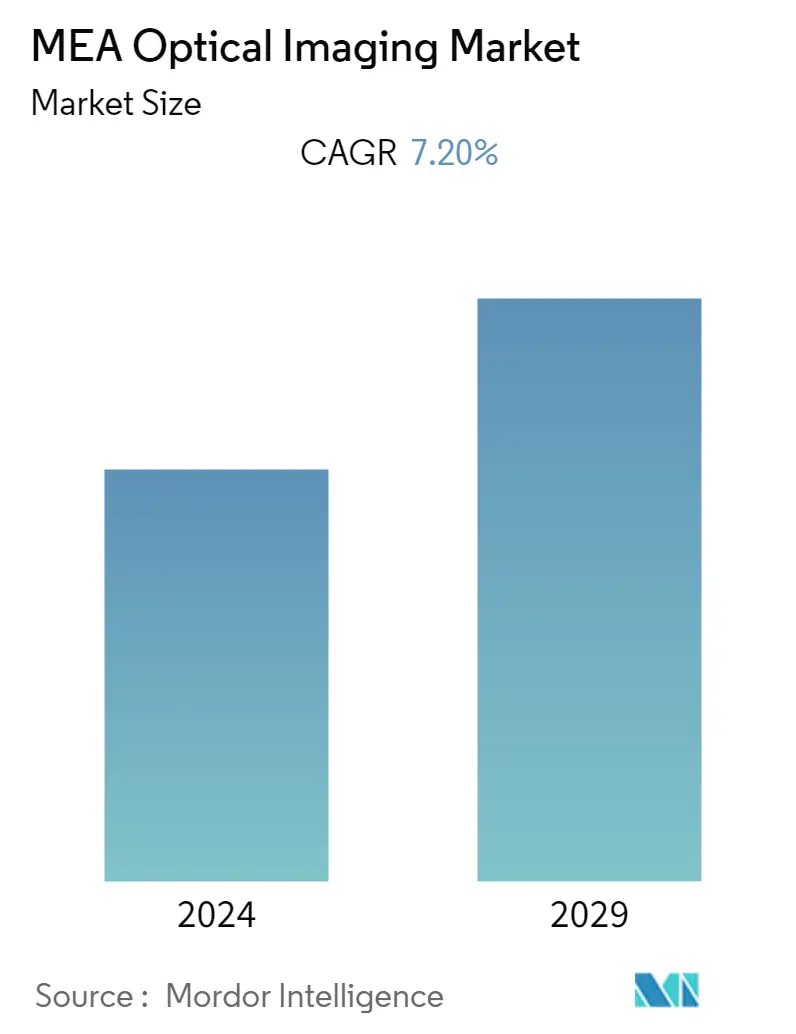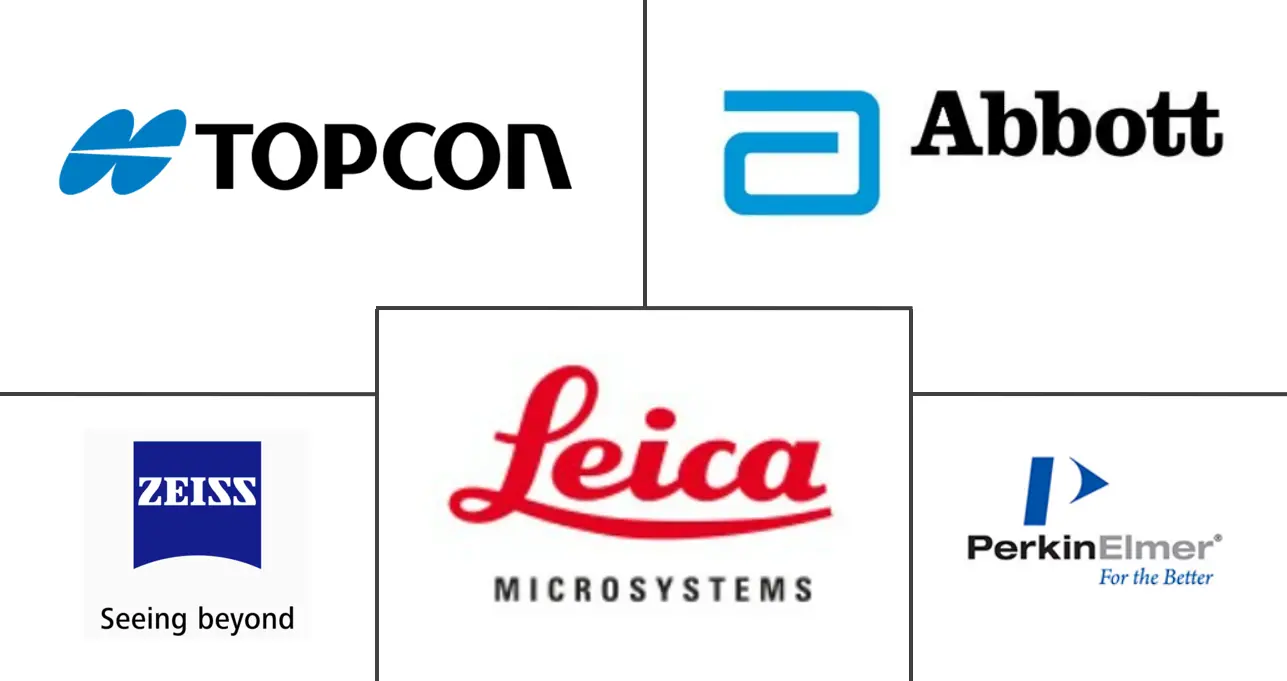Market Size of MEA Optical Imaging Industry

| Study Period | 2019 - 2029 |
| Base Year For Estimation | 2023 |
| Forecast Data Period | 2024 - 2029 |
| Historical Data Period | 2019 - 2022 |
| CAGR | 7.20 % |
| Market Concentration | Medium |
Major Players
*Disclaimer: Major Players sorted in no particular order |
Middle-East and Africa Optical Imaging Market Analysis
The Middle-East and African optical imaging market is expected to witness a CAGR of 7.2% during the forecast period (2022 - 2027). Optical imaging is an emerging technology with great potential for improving disease prevention, diagnosis, and treatment in the medical office or in the operating room. The pandemic witnessed a downward growth in the demand for optical imaging devices as most of the new ventures and surgeries were postponed to contain the spread of the COVID-19 virus.
- Optical imaging offers the potential to differentiate between soft tissues and between the affected tissues. This ability of optical imaging to differentiate between the healthy and infectious tissues creates a huge opportunity in the medical diagnosis industry.
- The growing concerns over eye surgeries in the Middle-East and African countries have further increased the application of optical imaging in ophthalmologic diagnosis. Optical imaging uses non-ionizing radiation, which significantly reduces patient radiation exposure compared to other harmful effects of radiation-based imaging.
- However, the market growth is restricted by factors such as stringent regulatory approval procedures, high costs of instruments, scarcity of skilled operators, and insufficient reimbursements policies for the optical imaging procedures.
Middle-East and Africa Optical Imaging Industry Segmentation
The report analyses the demand and revenue of the optical imaging market in the Middle-East and African countries based on the macroeconomic factors pertaining to the market. The report also analyses the demand for various product types for different applications such as Ophthalmology, Dentistry, Dermatology, and Cardiology.
- The study factors in the impact of COVID-19 on the Middle-East and African optical imaging market for modeling the forecast.
| By Technology | |
| Photoacoustic Tomography | |
| Optical Coherence Tomography | |
| Hyperspectral Imaging | |
| Near-Infrared Spectroscopy | |
| Other Technologies |
| By Product | |
| Imaging Systems | |
| Illumination Systems | |
| Optical Imaging Software | |
| Cameras | |
| Other Products |
| By Application Area | |
| Ophthalmology | |
| Oncology | |
| Cardiology | |
| Dermatology | |
| Neurology | |
| Other Application Areas |
| By Application | |
| Pathological Imaging | |
| Intraoperative Imaging |
| By End-user Industry | |
| Hospitals and Clinics | |
| Research and Diagnostic Laboratories | |
| Pharmaceutical Industry | |
| Biotechnology Companies | |
| Other End-user Industries |
| By Country | |
| Saudi Arabia | |
| United Arab Emirates | |
| South Africa | |
| Rest of MENA |
MEA Optical Imaging Market Size Summary
The Middle-East and Africa optical imaging market is poised for significant growth, driven by its potential to enhance disease prevention, diagnosis, and treatment, particularly in medical and ophthalmologic applications. Despite a temporary decline in demand during the pandemic due to postponed surgeries, the market is rebounding as the technology's ability to differentiate between healthy and infectious tissues presents substantial opportunities in medical diagnostics. The use of non-ionizing radiation in optical imaging reduces patient exposure to harmful effects, further boosting its appeal in ophthalmology. However, the market faces challenges such as stringent regulatory approvals, high instrument costs, a shortage of skilled operators, and inadequate reimbursement policies, which could hinder its expansion.
The region is witnessing notable advancements and collaborations in the optical imaging sector, with leading pharmaceutical companies partnering with eye hospitals to meet the rising demand for ophthalmic products. Strategic acquisitions and investments in healthcare infrastructure, such as the establishment of the National Health Regulatory Authority in Bahrain and the public healthcare system in Qatar, are supporting market growth. The market is moderately fragmented, with major players like Abbott Laboratories and Carl Zeiss Meditec AG dominating the landscape. Innovations, such as AI-based devices for remote glaucoma monitoring, are further enhancing market dynamics, indicating a promising future for optical imaging in the Middle-East and Africa.
MEA Optical Imaging Market Size - Table of Contents
-
1. MARKET INSIGHTS
-
1.1 Market Overview
-
1.2 Industry Attractiveness - Porter's Five Forces Analysis
-
1.2.1 Threat of Substitute Products
-
1.2.2 Bargaining Power of Buyers
-
1.2.3 Threat of New Entrants
-
1.2.4 Bargaining Power of Suppliers
-
1.2.5 Intensity of Competitive Rivalry
-
-
1.3 Industry Value Chain Analysis
-
1.4 Industry Policies
-
1.5 Assessment of the Impact of COVID-19 on the Market
-
-
2. MARKET SEGMENTATION
-
2.1 By Technology
-
2.1.1 Photoacoustic Tomography
-
2.1.2 Optical Coherence Tomography
-
2.1.3 Hyperspectral Imaging
-
2.1.4 Near-Infrared Spectroscopy
-
2.1.5 Other Technologies
-
-
2.2 By Product
-
2.2.1 Imaging Systems
-
2.2.2 Illumination Systems
-
2.2.3 Optical Imaging Software
-
2.2.4 Cameras
-
2.2.5 Other Products
-
-
2.3 By Application Area
-
2.3.1 Ophthalmology
-
2.3.2 Oncology
-
2.3.3 Cardiology
-
2.3.4 Dermatology
-
2.3.5 Neurology
-
2.3.6 Other Application Areas
-
-
2.4 By Application
-
2.4.1 Pathological Imaging
-
2.4.2 Intraoperative Imaging
-
-
2.5 By End-user Industry
-
2.5.1 Hospitals and Clinics
-
2.5.2 Research and Diagnostic Laboratories
-
2.5.3 Pharmaceutical Industry
-
2.5.4 Biotechnology Companies
-
2.5.5 Other End-user Industries
-
-
2.6 By Country
-
2.6.1 Saudi Arabia
-
2.6.2 United Arab Emirates
-
2.6.3 South Africa
-
2.6.4 Rest of MENA
-
-
MEA Optical Imaging Market Size FAQs
What is the current MEA Optical Imaging Market size?
The MEA Optical Imaging Market is projected to register a CAGR of 7.20% during the forecast period (2024-2029)
Who are the key players in MEA Optical Imaging Market?
Abbott Laboratories, Carl Zeiss Meditec AG, Leica Microsystems, Topcon Corporation and Perkinelmer Inc. are the major companies operating in the MEA Optical Imaging Market.

